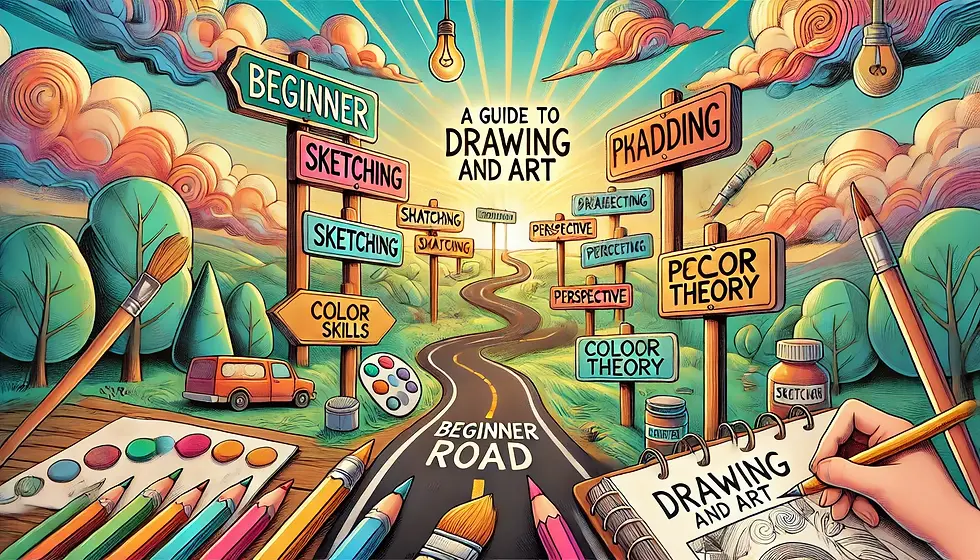Beginner Road: A Guide to Drawing and Art
- Yasser M.
- Feb 21
- 4 min read

Content:
1. Lines vs Planes
2. Perspective Guidelines
3. One-Point Perspective
4. Boxes in One-Point Perspective
5. Ellipses in One-Point Perspective
6. Cylinders in One-Point Perspective
1. Lines vs Planes:

Before diving into perspective, it's essential to understand the fundamental difference between lines and planes. These are the building blocks of any artwork and set the foundation for creating depth and realism.
Lines are the simplest drawing elements. They define edges, contours, and guidelines. Every great drawing starts with a single line, which can guide the eye and structure your composition.
Planes add a third dimension—depth. By connecting lines to form shapes like squares and rectangles, you create surfaces that suggest volume and space.
Why It Matters: Understanding how lines and planes interact is crucial for developing spatial awareness in your drawings, allowing you to craft scenes that feel alive and dimensional.
Warm-Up Exercise:


Practice:
Complete the tennis racket by drawing straight lines—focus on maintaining consistent spacing to create a realistic grid effect.
2. Perspective Guidelines:


Perspective is the secret sauce that transforms flat drawings into immersive, lifelike scenes. It tricks the eye into perceiving depth and distance, making your artwork come alive.
Key Concept: The horizon line represents the viewer’s eye level, and all perspective lines converge toward a vanishing point on this line.
Practice:
Draw at least three lines converging towards the horizon to practice visualizing depth.
Examine an existing piece of artwork and mark the perspective guidelines you observe—notice how they draw your eyes toward certain focal points.
Pro Tip: Use different line weights (thicker for closer objects, thinner for distant ones) to enhance the sense of depth in your drawing.
3. One-Point Perspective:


In one-point perspective, all lines converge toward a single vanishing point on the horizon line. This technique is perfect for scenes like roads, hallways, railways, or any straight-ahead view that naturally leads the eye inward into the distance.
Visual Cue: Think of standing in a long hallway where the walls, floor, and ceiling seem to meet at a point far away. That’s one-point perspective in action!
Practice:
Draw a plane in 1-point perspective so Woody doesn’t fall off the grid—this will help solidify your understanding of spatial positioning.
(Trick Challenge!) Sketch a plane in 1-point perspective but introduce an unconventional element—maybe skew the horizon for a dynamic effect.
Draw a plane in 1-point perspective that secures a flowerpot in place—focus on grounding the object realistically.
Pro Tip: Add shadows that follow the perspective lines to enhance the realism of your drawing.
4. Boxes in One-Point Perspective


Adding volume to planes by extending them transforms flat surfaces into three-dimensional boxes. This technique anchors objects within a space, making your drawings more believable.
Why It’s Important: Mastering boxes lays the groundwork for drawing more complex forms—everything from furniture to buildings starts with a box!
Practice:
Transform the plane into a box in 1-point perspective to make Woody feel more secure. Pay attention to proportion and how depth affects size.
Turn the flowerpot’s base into a 3D box in 1-point perspective to ensure it feels sturdy and balanced.
Challenge Yourself: Try stacking boxes at different depths and angles to create an interesting, layered composition.
5. Ellipses in One-Point Perspective

An ellipse represents a circle viewed from an angle, distorted by perspective. Learning to draw accurate ellipses is vital for creating rounded objects like wheels, bowls, or portals.
Visual Example: Imagine looking at a cup from above—it appears circular. Tilt your view, and it transforms into an ellipse!
Practice:
Draw an ellipse on each plane provided to create portals for Woody—this exercise trains your eye to handle curves in perspective.
Advanced Tip: Practice drawing ellipses from various angles and depths, adjusting the width of the ellipse as it moves closer or farther from the vanishing point.
6. Cylinders in One-Point Perspective

A cylinder combines straight lines and ellipses to create smooth, rounded forms. This basic shape is foundational for drawing bottles, pipes, columns, and even airplane bodies.
Understanding the Form: Visualize a soda can—it’s essentially a rectangle with ellipses on the top and bottom. That’s how you break down a cylinder in perspective.
Practice:
Redraw the body of an airplane using a cylinder form, ensuring it aligns with the vanishing point for accuracy.
Try another variation—this time, adjust the cylinder’s tilt to create dynamic movement.
Expert Tip: Add shading to emphasize the curvature of the cylinder and give your drawing more dimension.
Conclusion:
Mastering basic perspective principles is the gateway to elevating your drawing skills from flat sketches to immersive, realistic compositions. By understanding and practicing lines, planes, and perspective guidelines, you’ll unlock the ability to construct dynamic scenes and complex forms effortlessly.
Final Tips for Success:
Practice regularly—consistency is key to mastering perspective.
Analyze real-life objects and scenes to understand how perspective works in nature.
Don’t be afraid to experiment with angles, viewpoints, and compositions.
Remember: Every masterpiece starts with a single line. Keep practicing, stay curious, and let your creativity flourish!


























Comments